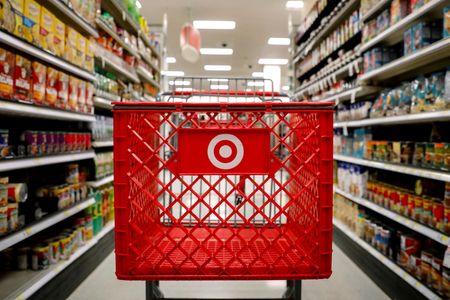By Aishwarya Venugopal
(Reuters) – Lower input costs and inventories, as well as extended price hikes are pushing a quicker-than-expected recovery in margins at U.S. consumer-facing firms including PepsiCo, Kraft Heinz, and Target, their recent earnings reports indicated.
Investors have zeroed in on gross margins, that faltered in the past several quarters, as high inflation and interest rates persist. Margins now seem brighter for these retailers and consumer-goods makers, who in the past few weeks sounded more optimistic about the metric than they did last quarter.
This is true especially for companies that make or sell essentials such as groceries and household staples, and even for restaurants and cafes, as strong wage gains in a tight labor market underpin consumer spending.
Still, people are being cautious about big-ticket, discretionary spending, and a bump from the lifting of COVID curbs in China has been slower than expected. Some analysts said a full recovery in margins is a few quarters away.
According to Refinitiv data as of May 12, quarterly margins for consumer discretionary components of the S&P 500 index is expected to increase year-over-year for every quarter this year.
“In this environment of uncertainty … (consumer staples) margins are going to be solid because most of the input costs going into staples are falling precipitously and that’s the positive,” said Art Hogan, chief market strategist at B Riley Wealth.
“They have (raised prices enough) … and they have held that price, so they are only going to see improvement in margins.”
Full-year sales and earnings outlook for Target Corp, which saw margins improve in the first quarter, implies a margin range of 4.7% to 5.0%, up from 3.5% in 2022, according to D.A. Davidson analyst Michael Baker.
Kraft Heinz Chief Financial Officer Andre Maciel said earlier this month that commodity costs were falling slightly faster than expected.
The maker of Philadelphia Cream Cheese and Jell-O said its gross margins in the quarter ended March improved by about 130 basis points. The company joined a list of consumer staples firms including Kellogg Co and PepsiCo Inc in raising its annual forecast for 2023.
PepsiCo reported March-quarter margins, or the ratio of gross profit to revenue for the company, that were higher than a year earlier and said its average selling price increased 16% in the quarter.
Prices at rival Coca-Cola Co rose by 11%, and though quarterly margins fell from the same period a year earlier, they improved from the prior quarter.
Margins at McDonald’s Corp and Starbucks Corp improved as well.
‘STUBBORN INFLATION’
But retail giant Walmart Inc, which gets about half of its revenue from low-margin groceries, took a more cautious stance on margin recovery on Thursday even as it raised its annual sales and profit targets.
“Stubborn inflation in dry grocery and consumables is one of the key factors creating uncertainty for us in the back half of the year,” Walmart CEO Doug McMillon said.
While its U.S. margins fell 41 basis points in the first quarter, it was an improvement on the 112-basis point decline in the fourth quarter.
Walmart said total inventory in the quarter ended April fell 7% versus flat in the fourth quarter. This is in line with other retailers who are stocking more of what consumers are buying in a weak economy.
Target said on Wednesday that inventory in the first quarter was 16% lower and it had doled out fewer clearance discounts.
“Even today against a very challenging backdrop we’re starting to assemble the building blocks for a recovery in our operating margin rate back towards its longer-term potential,” Target CFO said.
(Additional reporting by Deborah Sophia in Bengaluru; Editing by Sayantani Ghosh and Shounak Dasgupta)





